Menu
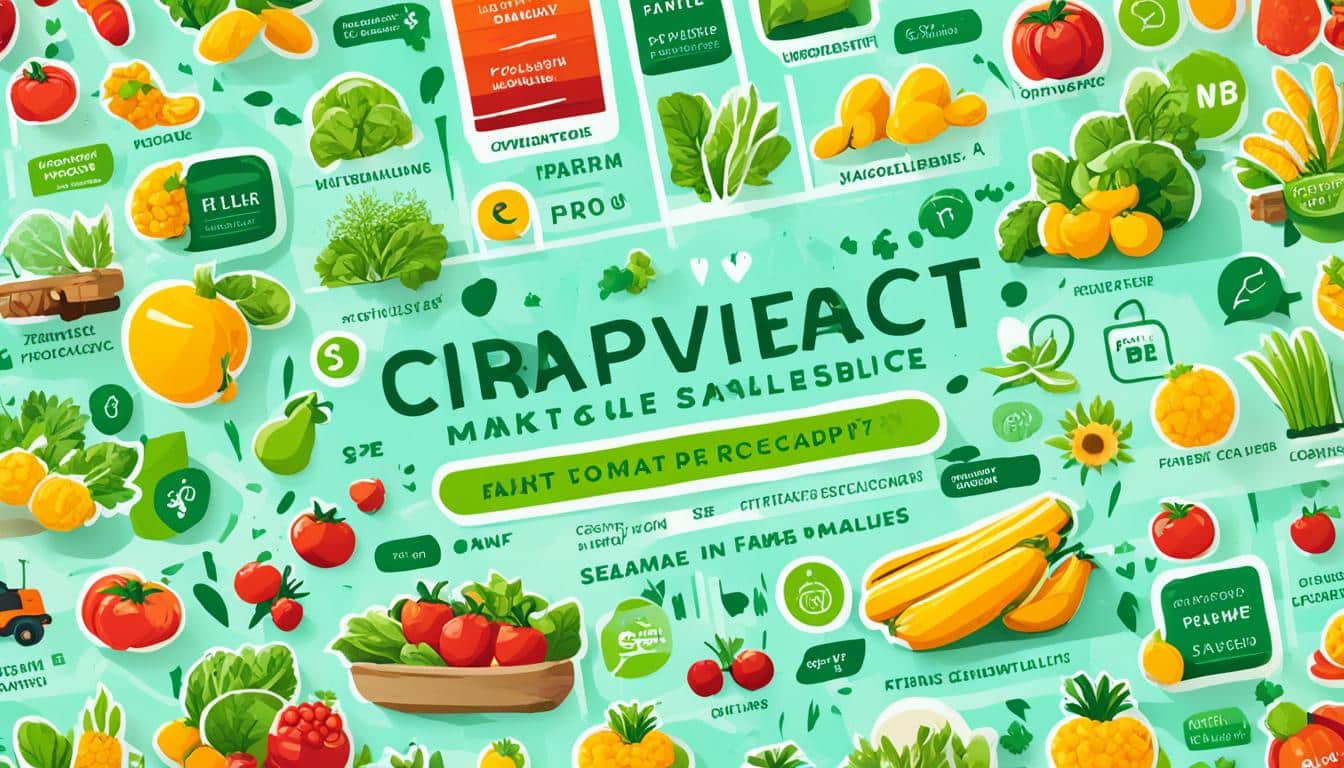
Did you know adults spend about 95 minutes daily on social media? This fact shows how farms can increase their presence using online platforms. By exploring digital marketplaces and e-commerce sites, farmers can reach more customers.
Farms can enhance their online presence by focusing on the 3 E’s: Entertain, Educate, and eCommerce. They can post content that’s both fun and informative, guiding people to buy products online. Tools for scheduling posts help keep their online efforts consistent.
Barn2Door is a key platform for farmers, offering them the tools they need. It gives personalised advice on social media and marketing. This support can boost their sales, making online sites essential for farmer’s success.
Farmers today can use online platforms for farm sales to grow their reach and sales. They can show their products to more people. This means they are not limited to selling only in their local area.
Amazon Agriculture connects farmers with customers worldwide. This gives them a chance to sell to millions globally.
Platforms like Kisaan Trade make buying and selling safe. They help both the farmer and the customer feel secure. Farmers can talk directly to buyers and close deals, answering all customer questions. This helps in building trust with buyers, important for repeat sales and a good online reputation.
Using technology, these platforms also solve problems like transport and the need for middlemen. For instance, Alibaba.com ensures safe and quality deals. Farmigo lets buyers subscribe to fresh produce from local farms directly. This benefits both buyers and farmers.
Modern farming relies on new technologies for better production. For example, Jiva has seen up to a 300% increase in crops using advanced methods. Farmers can now track their success and make smart choices using these tools.
Online platforms for farm sales are key for farmers today. They help farmers tell their story and sell directly. By focusing on being real and reliable, these platforms help farms grow and succeed.
Making a great farm website is key in today’s farming world. It should look good and work well on any device. This guide will help you do just that.
The first look people get of your site is vital. Use top-notch images and videos to show off your farm. Mix in your brand’s colours, images, and fonts for a memorable feel.
Make it easy for folks to find what they need. Simple menus and clear buttons help them learn about your products and services. This makes exploring your farm online a pleasure.
Tell your farm’s story to grab visitors. Share its history and what you stand for. This builds trust and a connection with your audience. Add enticing product descriptions to show the worth of what you offer.
Spice up your content with images, videos, and graphs. This keeps readers interested and makes information clear. Point out what makes your products special, like their quality or eco-friendliness.
By 2022, e-commerce is set to hit 5.4 trillion dollars. A website that works well on phones is a must. It offers a smooth visit no matter the device.
Choose a design that looks and works great on all screens. Local Line has easy-to-use options and SEO help for farm websites. This way, your site looks pro without you needing technical skills.
A mobile-friendly site isn’t just for now. It’s needed for farms to do well online in the future.
Getting farm websites seen online is key. A good SEO plan helps reach more people online. Since almost everyone starts their online journey with a search, being up there means more visitors. This is especially important for farms selling fresh, local produce.

Adding the right keywords to your website is vital for SEO. Longer, more specific keywords can catch the eye of people really looking for what you offer. Place these keywords well around your site to boost how often it pops up in searches. More search visits mean more potential customers.
Meta descriptions are like your website’s snapshot in search results. They help decide if someone clicks on your site. Make them appealing and clear with important keywords. This can improve the number of clicks your site gets. More clicks equals better SEO for you.
Alt text for images is good for SEO too. It describes images for those who can’t see them and helps search engines understand better. Include keywords in your alt text to boost visibility even more. This means your page can show up higher in searches, attracting the right people.
WebFX, with its 145+ experts in heavy equipment and over 1,100 client testimonials, showcases the transformative impact of tailored SEO campaigns for farms, making it a leader in enhancing online farm visibility.
Using Google Analytics and updating content often are great for SEO. These, along with smart internal links, make your site more user-friendly. A better experience leads to higher search rankings, proving the worth of a well-optimised website.
| SEO Metrics | Importance |
|---|---|
| Keyword Integration | Drives specific and targeted search traffic |
| Meta Descriptions | Enhances click-through rates |
| Alt Text | Improves image search results and accessibility |
| Google Analytics | Tracks effectiveness and provides valuable insights |
| Content Updates | Contribute to better rankings and site engagement |
| Internal Linking | Establishes site structure and boosts SEO |
For farmers, using social media marketing for agriculture is crucial. It helps connect you with billions of people on Facebook, Instagram, and Twitter. By creating an online farm sales strategy, you can boost both your profile and your sales.
First, figure out which social media sites work best for you. Facebook, with its 1.5 billion users, is great for telling detailed stories and engaging with your community. With 500 million people watching every day, Instagram is perfect for showing off your farm visually. Twitter, on the other hand, is good for quick updates and reaching out to a lot of people at once.
It’s vital to make interesting content about your farm. Show what you do every day, celebrate your wins, and tell your farm’s story. People like genuine and honest stories, which help them connect with you. Turning this content into printed materials, like newsletters, can help spread your message further.
Making sure your social media efforts are working is also key. Watching the data can tell you what your audience likes the most. Since many farms haven’t started using social media yet, this is a way to stand out.
Linking your social media to mail campaigns can also help. Adding a QR code to your mailings lets people easily find you online. Following up with a phone call can make that connection stronger. Always work to do better based on what people tell you and how they interact with your farm online.
| Platform | Daily Active Users | Strength |
|---|---|---|
| 1.5 billion | In-depth storytelling, community engagement | |
| 500 million | Visual storytelling | |
| 126 million | Real-time updates |
To sum up, using social media marketing for agriculture can make your farm more known and bring in more sales. A strong online farm sales strategy mixes interesting content with smart tracking. This approach can help your business grow and build a base of loyal customers.
It’s crucial to use the right social media for interacting with customers on farms. Knowing how each platform can show different farm aspects enhances customer and sales connection.
Many farmers find Facebook farm engagement vital due to its wide use. It helps build communities with tools for interactions and content promotion.
Posting often, replying to comments, and joining talks keeps customers loyal. With 80% of farmers using social media, Facebook is essential because of its many features and huge audience.
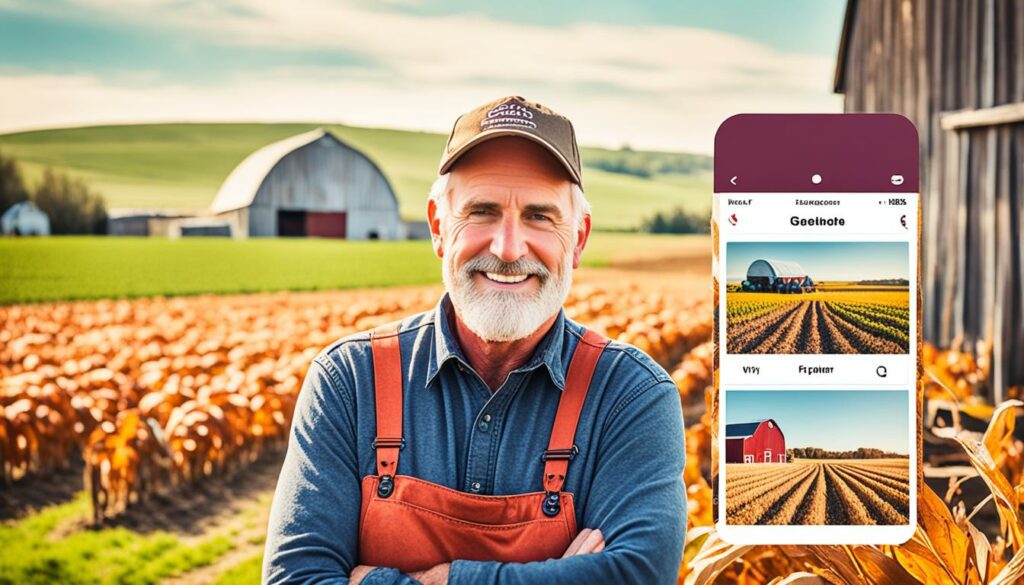
More women use Instagram than men (44% vs. 36%), making it great for female audiences.
Twitter shines for quick farm updates and events. It’s great for timely communication and quick audience interactions.
With a slightly younger audience than Facebook, it draws a diverse crowd. This regular Twitter use enhances Facebook farm engagement and strengthens the farm’s online presence.
| Platform | Primary Use | Statistic |
|---|---|---|
| Customer Engagement | 72% of adults in the US use social media in 2021 | |
| Visual Storytelling | Instagram use among women (44%) vs. men (36%) | |
| Real-Time Updates | 80% of farmers use social media regularly |
Creating an effective social media plan for farms means winning over your viewers. Use the Three E’s method: Entertain, Educate, and eCommerce. This helps farmers offer a variety of interesting content. It teaches followers about farm life and boosts sales.
Starting your content with real tales from the farm grabs people’s hearts. This can be stories about the crops, daily activities, or funny farm animal moments. Viewers love these glimpses into your life. It makes them feel closer to the farm. Influencers like Millie Adrian show us how real stories can make our audience love us more.
Today, people want to know where their food comes from. Talking about your farm’s good practices and green efforts makes followers trust you. Forbes says showing responsible farming lets people relate to you more. This can turn followers into dedicated customers.
Making sales through social media is key. Post links to your store and use clear messages to guide followers to buy. Promote special deals or new items. The Acree Brothers Realty Team shows us the power of linking good deeds and sales. This can boost your farm’s success.
By mixing entertainment, education, and sales, a farm’s social media can be really powerful. This approach builds a strong connection with your audience. It also helps sell more farm products, which is the main goal.
Social media content planning is key. Farmers need it to stay active online. If they plan posts well, they can talk to their followers without stopping their work. This way, they can keep their audience interested.
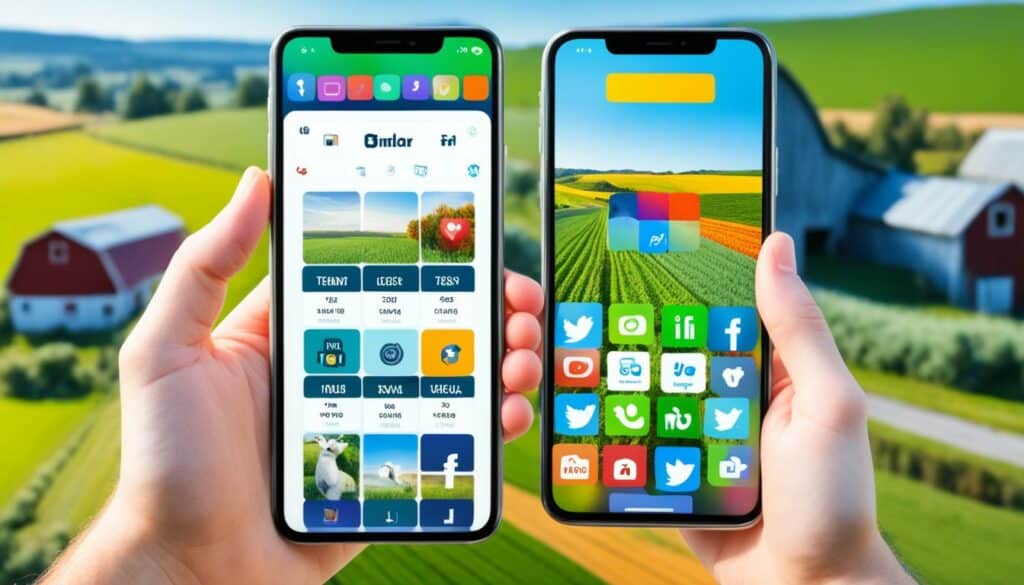
A content calendar lets farmers see their social media plans. It helps match posts to important dates and seasons on the farm. With a good calendar, they can mix posts that inform, entertain, and promote their work.
Tools like Hootsuite and Buffer are great for farm post scheduling. They let farmers set up posts in advance. Doing all their posts at once saves time. It also makes sure they post regularly, which keeps followers interested.
Knowing the best times to post is important for engagement. Different groups prefer different social media. For example, young adults like YouTube, while Facebook is big for women and wealthier people. By studying this info and using social media analytics, farmers can find the right times to post. This helps them reach more people.
“The toolkit from Maryland Farmers Market Association simplifies social media use for farmers and producers, providing a structured approach to content creation and scheduling.”
| Platform | Overall Usage (%) | 18-29 Age Group Usage (%) | 65+ Age Group Usage (%) | Women Usage (%) | Men Usage (%) |
|---|---|---|---|---|---|
| YouTube | 73 | 91 | 38 | – | – |
| 69 | – | – | 75 | 63 | |
| 37 | – | – | 43 | 31 |
In today’s world, connecting with people online is really important. It helps you build a trusting community. By talking with your audience a lot, you can make them like your brand more. They might become your regular customers. Let’s look at some ways to keep your online community interested.
Replying quickly to comments and messages really helps your online community. A study found that businesses who do this get more good reviews and recommendations. Quick replies make customers feel heard and valued.
Making interactive agricultural content is key to reaching your audience. Content that lets users interact can boost how often they engage by 30%. To do this, you can use polls, quizzes, live Q&A sessions, and videos that ask for their input. This makes your online space more engaging and interesting, which leads to stronger bonds with your audience.
It’s not just about posting. It’s also about making your fans feel at home. Show them what life on the farm is like. Share real stories and be open about how you do things. Businesses that are open have seen a 35% jump in how much their customers trust them. Combine this with fun and interactive content to make your community really tight-knit. This will bring you more loyal customers.
| Engagement Strategy | Percentage Increase in Positive Results |
|---|---|
| Exceptional Customer Service | 25% |
| Interactive Content | 30% |
| Transparency in Practices | 35% |
E-commerce platforms change how farmers sell. They offer an easy way to reach more customers online. Farmers can show off their products to more people.
Online sales save time and don’t need any paper or travel. This is a big help for farmers.
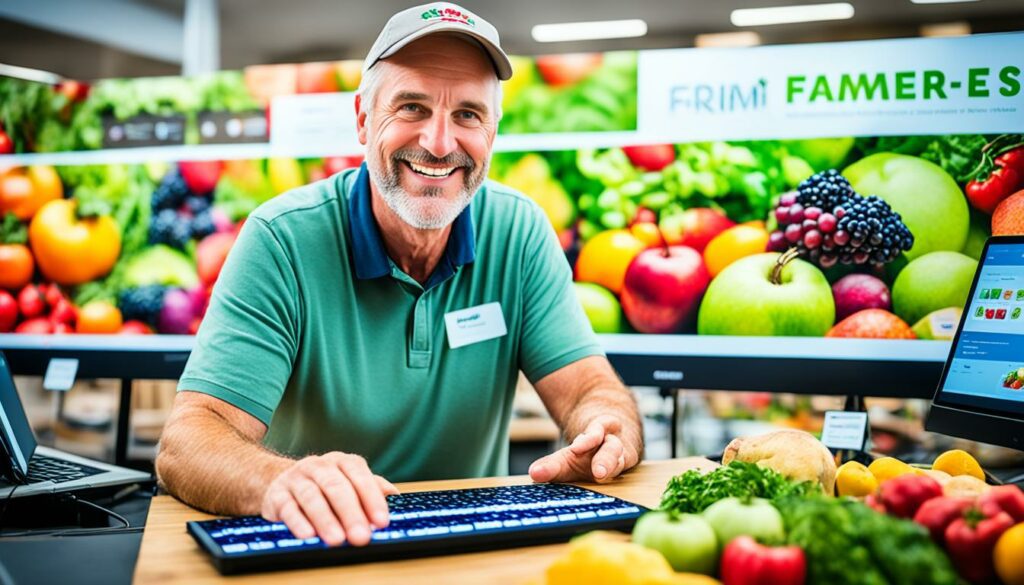
These websites help farmers choose the best seeds. They can see what grows well and fights off diseases. This info helps them save money by comparing prices from different sellers.
Farmers can sell directly to buyers and skip the middleman. Some online platforms even give out loans. This support helps farms grow.
For example, in 2020, global B2B e-commerce was worth USD 6.64 trillion and it will grow fast. North America made 14% of this money in 2020. This shows how big e-commerce can be for farming.
| Statistic | Detail |
|---|---|
| Global B2B E-commerce Market Size (2020) | $6.64 trillion |
| Expected CAGR (2021-2028) | 18.7% |
| North America B2B Agriculture Marketplace Revenue Share (2020) | 14% |
| E-commerce Food and Beverage Industry Revenue in the U.S. (2020) | $18.7 billion |
| Projected Revenue by 2025 | $25.7 billion |
In China, e-commerce fixes old ways of selling that lead to waste and lost money. Cloud computing helps run these sites well and without high costs. It’s great for small farmers who sell organic veggies.
In summary, using e-commerce can make farming more efficient and cheaper. It also lets farmers reach more people. It’s key for farms to grow and be green.
In the world of online sales, how you present your farm products is key. Good photos and descriptions can show off what makes your products special. This can make people want to buy from you.
To make your products stand out, talk about what makes them unique. This could be that they are organic, rare, or grown sustainably. Using the right words can make your products seem more valuable.
Taking good photos of your products is vital. Use high-resolution images in natural light to avoid shadows. Good pictures can help customers choose to buy from you.
Great product descriptions are as important as good photos. Tell customers what the product tastes like, how it feels, or how to use it. Sharing stories about your farm can also interest people.
By doing this on your website, you improve the way people see your products. This can lead to more sales and people coming back to buy again.
For example, showing that clearer, better described products get more interest can be powerful. It shows why it’s worth spending more time on your product descriptions and photos.
| Key Feature | Description | Impact |
|---|---|---|
| Organic Certification | Products grown without synthetic pesticides | Appeals to health-conscious consumers |
| Rare Crop Varieties | Unique and heritage varieties | Attracts buyers looking for exclusive produce |
| High-Resolution Photos | Clear and detailed images of produce | Creates trust and boosts purchase confidence |
| Descriptive Language | Engaging descriptions of taste and use | Enhances customer’s shopping experience |
Online promotions really help sell more on farms, especially since only 1% of Americans often go to farmers’ markets. Digital methods let you show your products to lots more people and sell more too.
Discounts on farm products make people buy more and come back. Successful farmers sell up to 80% through their email newsletters, which often have special deals. Given that 86% of buyers like keeping up with farm products through email, using emails to share discounts is smart.
Seasonal agricultural deals catch people’s eye and boost sales at certain times. For example, special promotions during holidays or peak harvest seasons not only please customers but also manage stock better. Frequent social media updates, around 3 times a week, spread the news well.

Working with platforms like Shopify, Squarespace, or BigCommerce makes selling online easier, no matter the farm’s size. With 4.8 million stores, Shopify is a top pick because it’s reliable and popular.
Exclusive offers online make people buy faster. With services like Shopify’s tiered pricing or Woo Express’s plans, farmers can meet everyone’s budget. Special bundles might introduce customers to new favourites, which can boost sales.
Successful online promotions entertain, educate, and push eCommerce on social media. Streamlining sales online saves time and makes farm businesses more profitable.
Being open and true about our farm’s journey has helped me earn trust from customers. We tell our story and values openly online. This makes customers more likely to support us, knowing we stand for the real deal.
Transparency in farming boosts loyalty to our brand. When customers know our methods, they value our ethical approach. They stick with us more, becoming loyal fans.
Telling the rich story of our produce builds deep connections. Sharing its path from seed to table engages our customers. They not only buy from us but root for our success, telling others too.
Honesty and openness have lifted our customer happiness and loyalty. Here’s how farm transparency touches different areas:
| Impact Area | Effect of Transparency |
|---|---|
| SEO Impact | Enhances search engine visibility through keyword integration. |
| Social Media Engagement | Builds trust and encourages interactive content. |
| Customer Conversion Rate | Increases purchase likelihood with compelling narratives. |
| Retention Rate | Strengthens loyalty through consistent and honest communication. |
Highlighting our farm transparency has deepened customer trust and loyalty to our brand.
Data is key in changing how farms market their products. With the right analytics, farmers can make better decisions. They can also run their farms more efficiently.
Checking website traffic is crucial for online marketing. Tools like Google Analytics help in this. They show what visitors do on the site and what they like most. This helps improve the website and make visitors happier.
For farms on social media, it’s vital to see how people interact with their posts. Tools like Facebook Insights tell farmers what posts work best. This information is then used to create more engaging content.
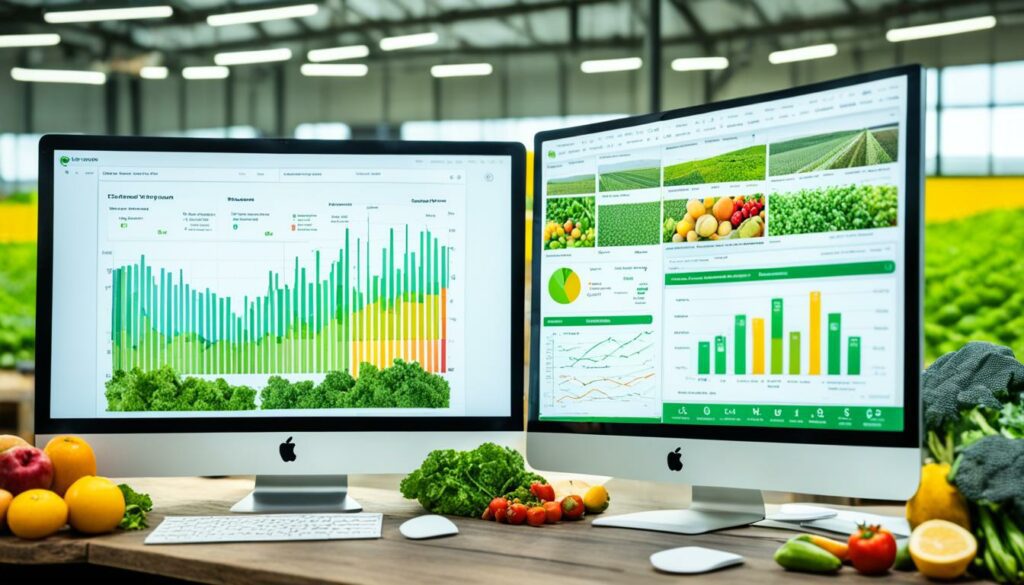
Sales data is also important for marketing on farms. Online tools can track what products sell well and when. This helps farmers stock what’s popular and market their products better.
| Metric | Tool | Benefit |
|---|---|---|
| Website Traffic | Google Analytics | Insights on visitor behaviour |
| Social Media Engagement | Facebook Insights, Instagram Analytics | Enhanced content strategy |
| Sales Data | E-commerce Platform Analytics | Optimised product offerings |
Using all these data types together helps farmers market smarter. By keeping up with the numbers, they can make their business better. They can also be sure their efforts in marketing pay off.
The digital age provides farmers with many chances to boost sales. By using e-commerce sites, farm websites, and social media, they can significantly improve their business. Retail e-commerce sales hit 4.28 trillion US dollars in 2020, with a possible growth to 5.4 trillion US dollars by 2022 (Statista).
Social enterprises are helping farmers connect directly with consumers. This cuts out middlemen and gives farms a better direct market. The global B2B e-commerce market reached USD 6.64 trillion in 2020 and is set to grow rapidly (Grand View Research).
In 2020, North America’s portion of the B2B e-commerce market was 14%. This showed great potential for the future. For the food and beverage e-commerce sector in the US, earnings hit 18.7 billion US dollars in 2020. They’re likely to grow to 25.7 billion dollars by 2025 (Statista Digital Market Outlook). This growth shows how digital platforms are becoming more important for sales.
Working with farmers from different areas allows for a wide range of products online. Platforms like WebFX offer special help for agriculture marketing. They make it easier for farmers to sell online, improving the shopping experience for customers.
Farm shops and markets are still key for sales, but blending them with online methods extends their impact. To succeed, farmers need to creatively combine online sales channels with new marketing techniques. This strategy can help them grow their market and make more money.
Today’s farming world is always changing. To succeed, farmers must use new ways to sell their products online. This shift to online sales shows farmers can grow their market and make more money. Magento is a great tool for farmers. It offers them a way to sell online that fits their needs, making their work smoother.
To get more customers, it’s key to market online using PPC ads and SEO. Looking at what other farmers do online can give great tips. This can help you stand out among others. Email marketing is also very good. It helps sell more seeds and keeps customers close.
It’s important to have a strong online presence in farming. Using strategies like seeding marketing and talking on social media can help. Many platforms, like Barn2Door and Harvie, have helped growers reach consumers better. Farm to People shows how knowing what customers want can change how you farm.
Farming is more digital every day. Having a smart online plan is a must. Farmers who use new ways to sell online do better. The future looks bright for those who do. Using digital tools and smart marketing leads to a strong future for farming.
Using online platforms helps farmers reach more customers. They can tell their story and show their products. This can lead to more sales by connecting with people on digital platforms.
For selling farming produce, sites like Barn2Door, Shopify, and BigCommerce are great. They give farmers ways to market and sell to customers directly. This can make their products more visible and accessible.
A farm website needs to look good, be easy to use, and work on phones. It should tell the farm’s story and show what’s for sale. This makes it inviting for visitors and helps them learn about and buy products.
SEO helps more people find your farm’s website online. By using the right words in your content and descriptions, your site can appear higher in search results. This draws in more visitors and potential buyers without extra marketing.
Facebook and Instagram are great for showing beautiful farm stories to engage with people. Twitter is good for quick news and talking directly to customers. Choose the best one depending on what you want to share and who you are sharing it with.
The ‘Three E’s strategy’ is about making content that entertains, educates, and leads to sales. By telling farm stories and teaching about practices, farmers can connect with more people. This could turn fans into buyers.
Planning and scheduling social media posts need a content calendar and tools. This keeps your posting regular and your focus on the farm. It’s also good for ensuring you have time for the farm’s other daily activities.
Talking and interacting with online visitors builds trust and a community feeling. Quickly replying to messages and creating fun posts gets people involved. This loyalty could mean more sales and a stronger online presence for the farm.
By using e-commerce, farmers can sell more widely. They can combine these platforms with good marketing to sell more fresh produce and products made on the farm. This way, the farm reaches more customers and makes sales easier.
Good product descriptions point out what makes farm produce special. Adding great photos makes them stand out even more. This attracts more people to see and buy what the farm offers.
Special deals and bundles get people to buy more. Limited-time offers and packages that mix different products make shopping exciting. This strategy can increase the number of items customers buy at once.
Being open about how the farm works and its values helps build trust. By sharing these things online, the farm can make more loyal customers. They may come back and recommend the farm to others.
Using data from the website, social media, and sales can guide marketing choices. By knowing what works best, farmers can improve how and where they share their farm’s story. This means focusing on what customers like and need.
Online platforms make farm products more visible and engaging. They help in reaching more customers and increasing sales. This is essential for the growth and success of farms today.